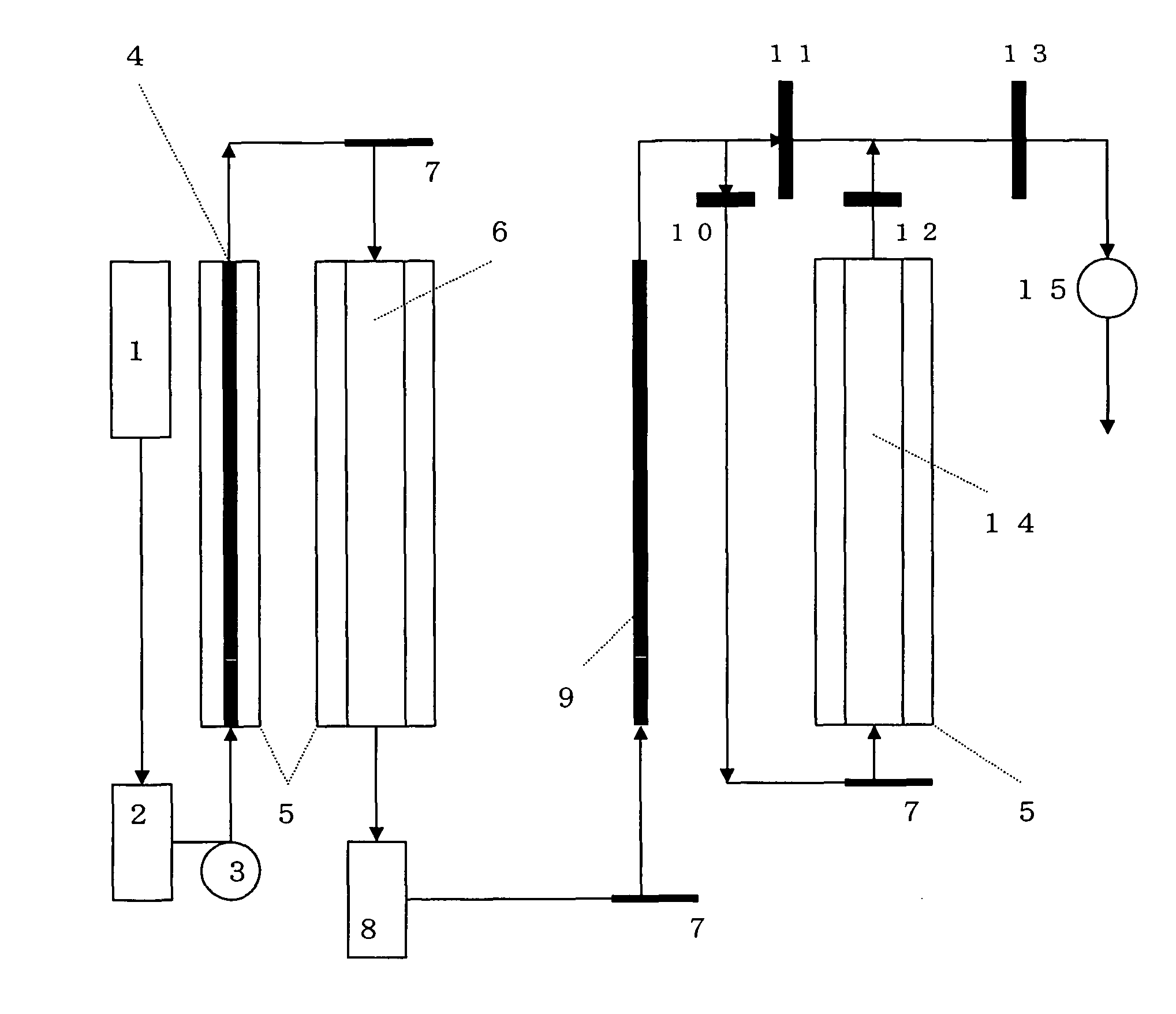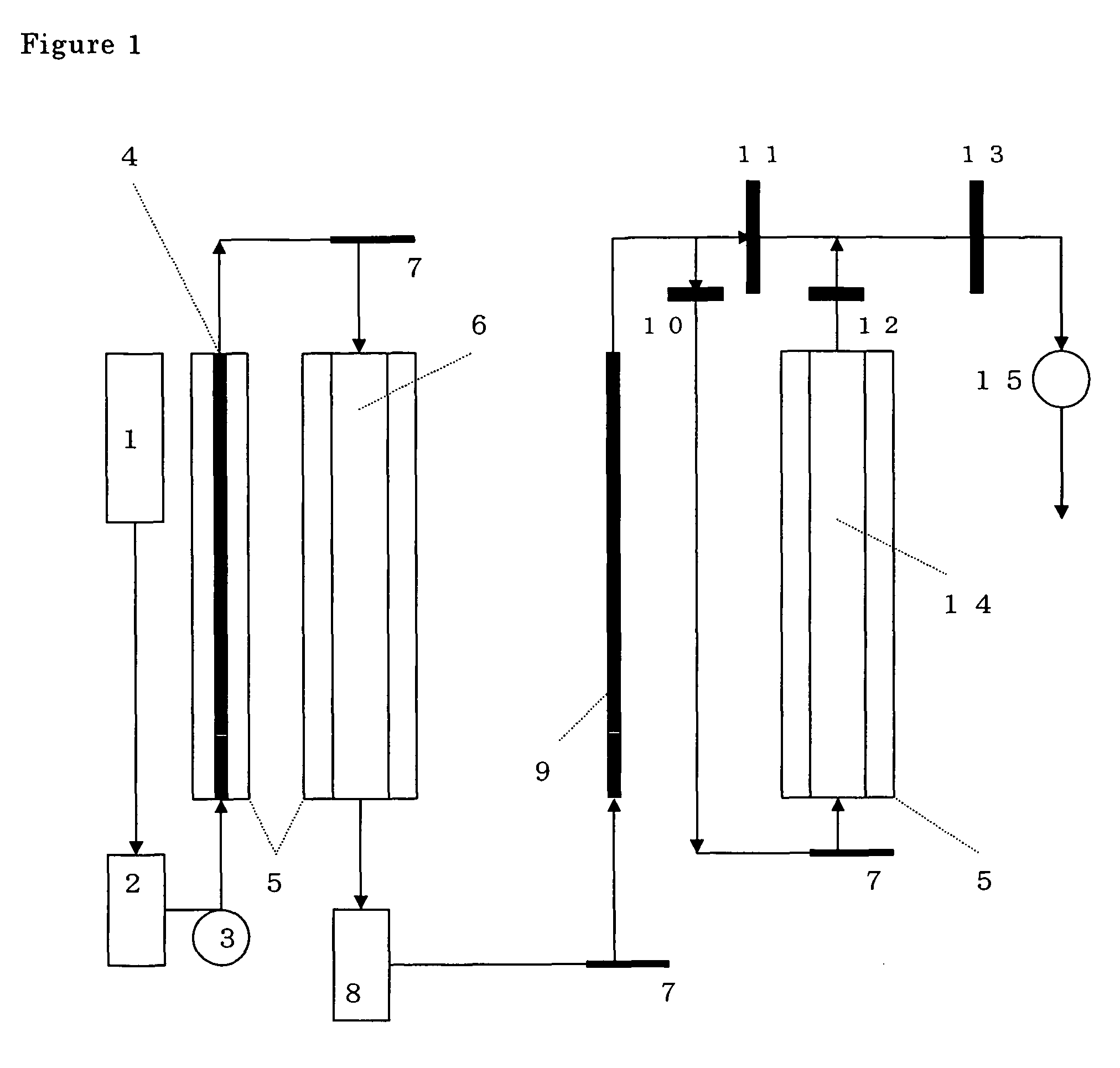Process for producing diesel fuel oil from fat
a technology of fat and oil, applied in the direction of biofuels, fatty acid chemical modification, fuels, etc., can solve the problems of small possibility of overcoming the problem in the near future, a large amount of glycerol, etc., and achieve the effect of suppressing the pressure in the following step of methanol synthesis
- Summary
- Abstract
- Description
- Claims
- Application Information
AI Technical Summary
Benefits of technology
Problems solved by technology
Method used
Image
Examples
example 1
[0063]The gasification of an aqueous solution of glycerol was conducted using an apparatus shown in FIG. 1.
[0064]In the present example, stop valve A 10 is closed, stop valve B 11 is opened and stop valve C 12 is closed. The reaction tube for synthesis of methanol is not used.
[0065]A reaction tube for gasification 6 (a tube made of stainless steel SUS316; the outer diameter: 6.24 mm; the thickness: 1.24 mm; and the length: 1 m) was heated by an electric heater 5. The pressure was controlled at 3 MPa and the temperature of the gasification was controlled at 780° C. by operations of a liquid transfer pump 2 (INTELLIGENT HPLC PUMP; manufactured by NIPPON BUNKO Co., Ltd.) and a back pressure valve 13 (a fully automated pressure valve SCF-BPQ; manufactured by NIPPON BUNKO Co., Ltd.).
[0066]A glycerol solution containing water in the same amount by mole as that of glycerol was prepared and used as the solution for the treatment (the content of glycerol: 84% by weight). The prepared solutio...
example 2
[0068]The same procedures as those conducted in Example 1 were conducted except that a catalyst which was prepared by supporting nickel on alumina and formed into a size of 1 mm was packed into a latter half portion having a length of 50 cm of the reaction tube of gasification. The composition of the sample gas was found to be as follows: carbon monoxide: 23%; hydrogen: 63%; and carbon dioxide gas: 14%. Almost no methane was found.
example 3
[0069]In the present example, synthesis of methanol was conducted continuously after the gasification of glycerol. Therefore, stop valve A 10 was opened, stop valve B 11 was closed, and stop valve C 12 was opened.
[0070]The condition of the gasification was the same as that in Example 2 except that the pressure of the operation was 5 MPa.
[0071]The material, the diameter and the length of the reaction tube for synthesis of methanol 14 were the same as those of the reaction tube for gasification. A portion having a length of 1 m of the reaction tube for synthesis of methanol was packed with a catalyst which was prepared by supporting copper oxide and zinc oxide formed from the respective metal nitrates in accordance with the precipitation process on alumina and formed to a size of 1 mm. The gas discharged from the reaction tube of gasification 6 was cooled in a cooling tube 9 and introduced into the reaction tube for synthesis of methanol 14. The temperature of the gas was controlled a...
PUM
| Property | Measurement | Unit |
|---|---|---|
| temperature | aaaaa | aaaaa |
| pressure | aaaaa | aaaaa |
| temperature | aaaaa | aaaaa |
Abstract
Description
Claims
Application Information
 Login to View More
Login to View More - R&D
- Intellectual Property
- Life Sciences
- Materials
- Tech Scout
- Unparalleled Data Quality
- Higher Quality Content
- 60% Fewer Hallucinations
Browse by: Latest US Patents, China's latest patents, Technical Efficacy Thesaurus, Application Domain, Technology Topic, Popular Technical Reports.
© 2025 PatSnap. All rights reserved.Legal|Privacy policy|Modern Slavery Act Transparency Statement|Sitemap|About US| Contact US: help@patsnap.com


